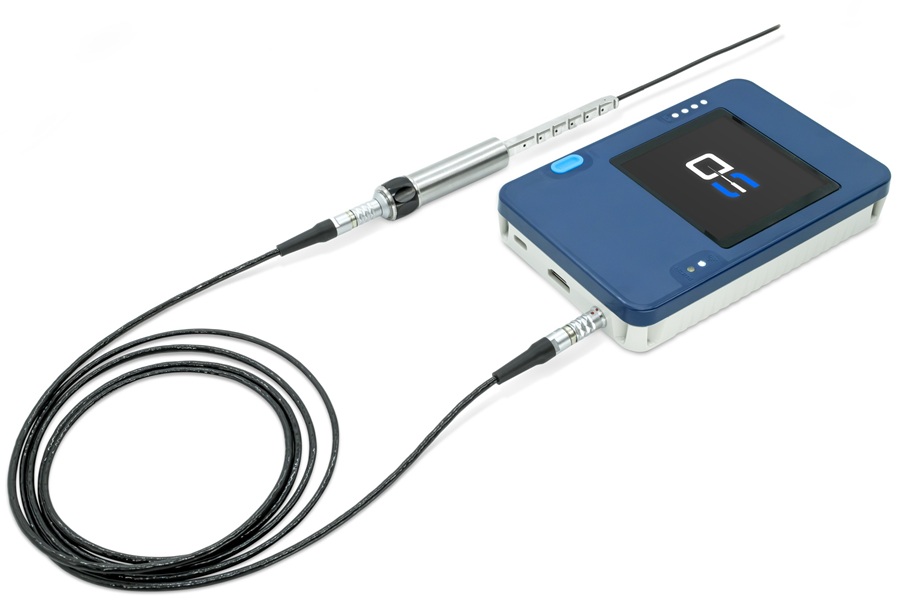AI Tool Pairs Protein Pathways with Drug Side Effects and Patient Comorbidities to Suggest Targeted COVID-19 Treatments
|
By HospiMedica International staff writers Posted on 25 Oct 2021 |

A new artificial intelligence (AI)-based tool helps clinicians understand and better predict which adverse effects their COVID-19 patients could experience, based on comorbidities and current side effects - and, in turn, also helps suggest specific FDA-approved drugs that could help treat the disease and improve patient health outcomes.
Researchers at the Georgia Institute of Technology (Atlanta, GA, USA) and Emory University (Atlanta, GA, USA) are trying to help clinicians sort through these factors and spectrum of patient outcomes by equipping healthcare professionals with a new “decision prioritization tool.” The symptoms and side effects of COVID-19 are scattered across a diagnostic spectrum. Some patients are asymptomatic or experience a mild immune response, while others report significant long-term illnesses, lasting complications, or suffer fatal outcomes.
The team’s new methodology, or tool, is called MOATAI-VIR (Mode Of Action proteins & Targeted therapeutic discovery driven by Artificial Intelligence for VIRuses. Researchers report it predicts 24 out of 26 major clinical manifestations of Covid-19 and their underlying disease-protein-pathway relationships. Those clinical manifestations cover a range of issues including acute respiratory distress, blood clotting issues, cytokine storms, low blood oxygen and white blood cell counts, and even bone marrow failure. The commonly reported loss of smell or taste, along with unusual neurological symptoms such as “brain fog” have received widespread attention - as have considerations for patients who have previous health problems, or comorbidities, that could place them in higher risk categories related to COVID-19.
According to the researchers, most known diseases are due to the “malfunction and interaction of many proteins,” and notes that it’s a collective effect - a “many-targeted protein effect.” The team’s new AI methodology is identifying as many targets as possible of an interacting nature to predict a complex response from a complex set of interactions. It is also well-understood in the medical community that comorbidities - existing and chronic health factors such as diabetes, obesity, autoimmune disorders, and other conditions that affect the immune system - can play an outsized a role in risk factors related to COVID-19. Those comorbidities can be plugged into the team’s algorithm, too, say the researchers. The MOATAI-VIR methodology helps identify the common proteins of the comorbidities in relation to the parent disease. A clinician can then target the diseases with drugs. Researchers report that this specific methodology had 72% success in 123,146 drug-indication pair predictions found by the research team.
“It’s still the question of, what’s causing the side effects?” said Jeffrey Skolnick, professor and Mary and Maisie Gibson Chair in the School of Biological Sciences, and corresponding author for the study. “So, you lost sense of smell and got brain fog - and another (patient) had respiratory distress, and another can’t remember the day of the week. What we’ve identified are the possible mode of action drivers for these various conditions, which is now setting the stage for who’s getting what side effects.”
“For a given disease, we prioritize them by the proteins that are most in common with the comorbid diseases to the given disease, giving rise to the particular complication, such as respiratory failure. This identifies the putative (assumed) driver proteins for the given complication,” added Skolnick. “Then we select repurposed drugs in two ways - we screen the most common comorbid proteins for their most frequent binding to repurposed drugs. For the set of comorbid diseases to a given complication, choose the drugs that treat the most complications.”
It’s critical to find the right drugs for those complications and side effects - and using the new “decision tool” can help do that, Skolnick says.
Georgia Institute of Technology
Emory University
Latest COVID-19 News
- Low-Cost System Detects SARS-CoV-2 Virus in Hospital Air Using High-Tech Bubbles
- World's First Inhalable COVID-19 Vaccine Approved in China
- COVID-19 Vaccine Patch Fights SARS-CoV-2 Variants Better than Needles
- Blood Viscosity Testing Can Predict Risk of Death in Hospitalized COVID-19 Patients
- ‘Covid Computer’ Uses AI to Detect COVID-19 from Chest CT Scans
- MRI Lung-Imaging Technique Shows Cause of Long-COVID Symptoms
- Chest CT Scans of COVID-19 Patients Could Help Distinguish Between SARS-CoV-2 Variants
- Specialized MRI Detects Lung Abnormalities in Non-Hospitalized Long COVID Patients
- AI Algorithm Identifies Hospitalized Patients at Highest Risk of Dying From COVID-19
- Sweat Sensor Detects Key Biomarkers That Provide Early Warning of COVID-19 and Flu
- Study Assesses Impact of COVID-19 on Ventilation/Perfusion Scintigraphy
- CT Imaging Study Finds Vaccination Reduces Risk of COVID-19 Associated Pulmonary Embolism
- Third Day in Hospital a ‘Tipping Point’ in Severity of COVID-19 Pneumonia
- Longer Interval Between COVID-19 Vaccines Generates Up to Nine Times as Many Antibodies
- AI Model for Monitoring COVID-19 Predicts Mortality Within First 30 Days of Admission
- AI Predicts COVID Prognosis at Near-Expert Level Based Off CT Scans
Channels
Critical Care
view channel
AI Tool Reduces Serious Complications and Readmissions After Colorectal Cancer Surgery
Readmissions and complications after colorectal cancer surgery remain a major challenge for both patients and healthcare systems. These setbacks increase suffering, prolong recovery, and result in high... Read moreTime-Released Gel Eliminates Residual Brain Tumor Cells Post Resection
High-grade gliomas are among the most aggressive brain tumors, with a poor prognosis even after surgical removal. Standard chemoradiotherapy only modestly improves survival, while infiltrative residual... Read moreSurgical Techniques
view channel
World's First Transcatheter Smart Implant Monitors and Treats Congestion in Heart Failure
Heart failure is one of the leading causes of hospitalization worldwide, with millions of patients requiring ongoing treatment to manage congestion. Current therapies often involve tracking remotely measured... Read more
Hybrid Endoscope Marks Breakthrough in Surgical Visualization
For more than three decades, surgical endoscopy has depended on either rigid or flexible scopes, each with major drawbacks. Rigid scopes offer precision but limit maneuverability, while flexible scopes... Read more
Robot-Assisted Bronchoscope Diagnoses Tiniest and Hardest to Reach Lung Tumors
Lung cancer is one of the deadliest cancers in Europe, killing around a quarter of a million people annually. Survival rates are much higher when tumors are diagnosed at an early stage, but the tiniest... Read more
Diamond-Titanium Device Paves Way for Smart Implants that Warn of Disease Progression
Medical implants such as stents, prosthetics, and drug-release systems often rely on batteries that take up space, wear out, and eventually require replacement surgery. These limitations increase risks... Read morePatient Care
view channel
Revolutionary Automatic IV-Line Flushing Device to Enhance Infusion Care
More than 80% of in-hospital patients receive intravenous (IV) therapy. Every dose of IV medicine delivered in a small volume (<250 mL) infusion bag should be followed by subsequent flushing to ensure... Read more
VR Training Tool Combats Contamination of Portable Medical Equipment
Healthcare-associated infections (HAIs) impact one in every 31 patients, cause nearly 100,000 deaths each year, and cost USD 28.4 billion in direct medical expenses. Notably, up to 75% of these infections... Read more
Portable Biosensor Platform to Reduce Hospital-Acquired Infections
Approximately 4 million patients in the European Union acquire healthcare-associated infections (HAIs) or nosocomial infections each year, with around 37,000 deaths directly resulting from these infections,... Read moreFirst-Of-Its-Kind Portable Germicidal Light Technology Disinfects High-Touch Clinical Surfaces in Seconds
Reducing healthcare-acquired infections (HAIs) remains a pressing issue within global healthcare systems. In the United States alone, 1.7 million patients contract HAIs annually, leading to approximately... Read moreHealth IT
view channel
Printable Molecule-Selective Nanoparticles Enable Mass Production of Wearable Biosensors
The future of medicine is likely to focus on the personalization of healthcare—understanding exactly what an individual requires and delivering the appropriate combination of nutrients, metabolites, and... Read moreBusiness
view channel
Philips and Masimo Partner to Advance Patient Monitoring Measurement Technologies
Royal Philips (Amsterdam, Netherlands) and Masimo (Irvine, California, USA) have renewed their multi-year strategic collaboration, combining Philips’ expertise in patient monitoring with Masimo’s noninvasive... Read more
B. Braun Acquires Digital Microsurgery Company True Digital Surgery
The high-end microsurgery market in neurosurgery, spine, and ENT is undergoing a significant transformation. Traditional analog microscopes are giving way to digital exoscopes, which provide improved visualization,... Read more
CMEF 2025 to Promote Holistic and High-Quality Development of Medical and Health Industry
The 92nd China International Medical Equipment Fair (CMEF 2025) Autumn Exhibition is scheduled to be held from September 26 to 29 at the China Import and Export Fair Complex (Canton Fair Complex) in Guangzhou.... Read more










.jpg)




